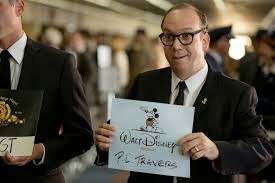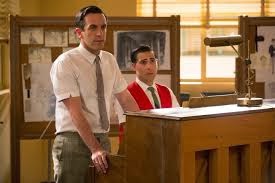P.L. Travers wrote the Mary Poppins books, and fought for 20
years to not allow Walt Disney to turn her beloved character into one of his
movies. This movie covers the last part
of that story, where he finally gets her to come to L.A. and sign over the rights
to the characters.
In case you haven’t seen Mary Poppins (what is wrong with
you?), it was released by Disney in 1964, starring Julie Andrews and Dick Van
Dyke. It was a touching and funny story
about some children and a magical nanny, but also about the importance of
family and being there for your children.
It is exceptional.
Saving Mr. Banks tells the behind the scenes story of Disney
essentially woo-ing the rights away from P.L. Travers, who was a miserable
woman, but was using that miserable personality to cover-up some trauma from a
difficult childhood. As she reluctantly
travels to Los Angeles and goes through the process of working with the writers
and lyricists, she reflects on that childhood – and that allows this movie to
tell the two stories in a parallel fashion.
When she was a very young child, her father worked as a bank manager in
Australia. The family had to move out to
the middle of nowhere as he got a new job, and she idolized his imaginative
take on life. He preferred to have fun
pretending, and not to work, but he was also very much an alcoholic, losing
work, and disappointing his wife. It’s
very clever, and has some genuinely moving moments when you realize why she is
fighting so hard to protect her creations.
It is directed by John Lee Hancock, who directed The Blind
Side and the Alamo, but perhaps is most notorious for being the director of
Snow White and the Huntsman (he was the one who was caught snogging with
Kristen Stewart, causing the breakup between her and R-Patz! The Horror!
Sarcasm!) And, while I always say
that film is the director’s medium, this movie really benefits from a stellar
cast, and a director smart enough to let them work their own magic.
- Emma Thompson plays P.L. Travers with class, elegance, and some world-class bitchiness. She is aggressive and unapologetic when dealing with Disney and his employees. She cares only about protecting what she sees as the most important thing to her, Mary Poppins. Thompson’s portrayal of Travers is almost flawless as she gradually starts to accept the translation of her literary character to film. Even more impressive is the pictures and recordings of the real Travers over the end credits, so that you know exactly how good a job Thompson did.
- Tom Hanks – who, again, is probably one of the best actors working today – plays Disney perfectly. I have some memories of seeing Walt Disney footage on the Magical World of Disney TV shows, and Hanks is incredible. Again he takes on a different accent, which seems to be perfect. He plays Disney absolutely as the friendly, warm creator of Disneyland – but you also get to see the moments of the man who did create an empire, and was not used to taking No for an answer. He was self-assured, and confident, and Hanks covers both very well.
- Paul Giamatti as Ralph, the driver, was one of the highlights of this movie. It’s a small role, but he’s quietly perfect in it – he never lets Travers bring him down, no matter how mean to him she is.
- Bradley Whitford plays writer Don DaGradi, and does a good job in being bewildered by Travers, but then finding a way to work with her.
- B.J. Novak and Jason Schwartzman play Robert and Richard Sherman, the musicians and lyricists who did the songs for Mary Poppins. They are small roles, but both of them are memorable, and have some great scenes.
- Rachel Griffiths plays the real-life inspiration for Mary Poppins, Aunt Ellie, who comes to help Travers’s family in flashbacks as they struggle in the outback. She has very few scenes, but plays them just right, and you can see how Travers pulls from her to create Mary Poppins.
- Ruth Wilson plays the mother in the flashbacks, and really does a great job as you see her slowly start to unravel as the story goes on.
- The “Mr. Banks” of the title is played by Colin Farrell, who plays Travers Goff, the father in the flashbacks. He’s incredibly fun as a father, and you can see why his daughter wants to be just like him. However, he is not great as a father, and his drinking and lack of ambition slowly start to drive the family to ruin. The decline is well-depicted, and you really start to feel for the family and the daughter in particular, and can see how she created these characters, and why they are so important to her. Honestly, he probably should get a nomination for supporting actor.
Overall, the movie is a bit long in places, but it is a
touching story. How much of it is
accurate is of course, up to the historians to debate, but it is not a
documentary, it is a movie – and it is by Disney, so it is a bit polished for
them. It’s touching, it’s entertaining,
and it has some fantastic performances.
6 out of 10 – so far, the second best of the Award-season
flicks I’ve seen (second to Captain Phillips).
Gained points for Giamatti, what a great job he does. Lost points for not fully using the
Australian outback to its potential – kangaroos, crocodiles, etc. Gained points for Disney handing out
pre-signed cards at Disney-land. Also
gained points for the real pictures over the credits.
Bonus Video 1:
Bedknobs and Broomsticks – similar to Mary Poppins, but with Angela
Lansbury from 1971.
Bonus Video 2: Disney - doing some Disney stuff, so you can see how good Hanks is.
Bonus Video 3: Cast
Interviews:










No comments:
Post a Comment